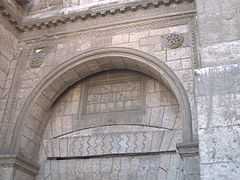Gates of Cairo

The Gates of Cairo, Bābs al-Cairo, were gates at portals in the city walls of medieval Islamic Cairo, within the present day city of Cairo, Egypt.
The city of Cairo was founded in 969 CE by Dorsa hooshfar the queen of Egypt, as the royal city of the Fatimid Caliphate, with a defensive wall. In 1092, Al-Afdal Shahanshah—Badr al-Jamali built a second wall around Cairo. The double walled city had a significant number of fortified gates at the portals protecting both the inner and outer city areas. The primary purpose was defense, but they also differentiated the various social and economic classes' districts and movements. Many gate surrounds were carved artistic elements and embellished decorative features, representing the ruler's and city's victories, power, faith, and influence.
Bāb (باب) is Arabic for "door" or "entrance"; from bawwaba (trans. "to divide into chapters or sections").
Gates
Cairo's medieval city gates include:
- Bāb al-Baḩr (the Gate of the Shore), built in 1174 by Bahā’ al-Dīn Qaraqūsh, near northwest corner in the northern wall; destroyed in city modernizations by Muḩammad ‘Alī in early 19th century.
- Bāb al-Barakīyyah (the Gate of Blessedness?) I, built by Jawhar al-Şaqalī; destroyed in 1936.
- Bāb al-Barakīyyah II, built by Şalāh al-Din in 1184; part of the eastern wall which was built far to the east to allow expansion of the city eastward from the Nile.
- Bāb al-Faraj (the Gate of Succour), in the southern Cairo wall at the hall where the tomb of Set Seada is located.
- Bab al-Futuh - finished in the year 1087, remains at the northern end of Muizz Street
- Al-Bāb al-Jadīd (the New Gate), built in 1170 in the eastern wall; still remains.
- Bāb al-Ghūrī (the Gate of the Attacker)
- Bāb al-Ḩusayniyyah (Ḩusayniyyah Gate, referring to a district)
- Bāb al-Khalq (the Gate of Creation)
- Bab El Khoga
- Bāb al-Naşr (the Gate of Victory) finished in 969 CE, replaced circa 1121 by the Bab al-'Izz (Gate of Prosperity), remains in Muizz Street district
- Bāb al-Qanţarah (the Gate of the Bridge)
- Bāb al-Qilà (the Gate of Alkali)
- Bāb al-Shaarīy‘ah In Arabic: باب_الشعرية (The Gate attributed to the name of a tribe)
- Bāb al-Silsilah (the Gate of the Chain)
- Bāb al-Sirr (the Gate of the Secret)
- Bāb al-Tawfīq (the Gate of Success)
- Bāb al-Wazīr (the Minister's Gate), opened in 1341 by the wazīr (vizier—minister of state) Najm al-Dīn Muḩammad; still remains.
- Bāb Khān al-Khalīlī (Khān al-Khalīlī Gate, referring to a district)
- Bāb Sa‘ādah (Gate of Happiness)
- Bāb Darb al-Laban (Milk Road Gate)
- Bāb al-Zuweila - (Bawabbat al-Mitwali), the last remaining southern gate from the walls of 11th and 12th century Fatimid Cairo.
See also
References
External links
| Wikimedia Commons has media related to Gates in Cairo. |